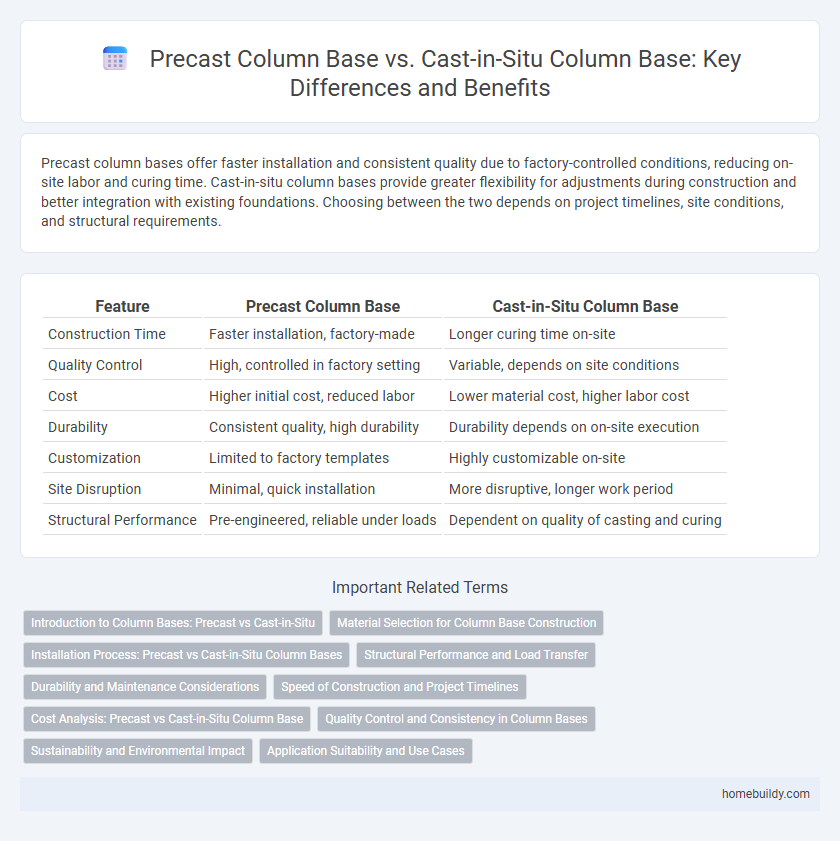Precast column bases offer faster installation and consistent quality due to factory-controlled conditions, reducing on-site labor and curing time. Cast-in-situ column bases provide greater flexibility for adjustments during construction and better integration with existing foundations. Choosing between the two depends on project timelines, site conditions, and structural requirements.
Table of Comparison
| Feature | Precast Column Base | Cast-in-Situ Column Base |
|---|---|---|
| Construction Time | Faster installation, factory-made | Longer curing time on-site |
| Quality Control | High, controlled in factory setting | Variable, depends on site conditions |
| Cost | Higher initial cost, reduced labor | Lower material cost, higher labor cost |
| Durability | Consistent quality, high durability | Durability depends on on-site execution |
| Customization | Limited to factory templates | Highly customizable on-site |
| Site Disruption | Minimal, quick installation | More disruptive, longer work period |
| Structural Performance | Pre-engineered, reliable under loads | Dependent on quality of casting and curing |
Introduction to Column Bases: Precast vs Cast-in-Situ
Precast column bases offer enhanced quality control and faster installation times due to factory manufacturing, reducing on-site labor and weather-related delays. Cast-in-situ column bases provide flexibility in design adjustments and seamless integration with existing structural elements, accommodating complex site conditions. The choice between precast and cast-in-situ depends on factors like project timeline, site accessibility, and load requirements.
Material Selection for Column Base Construction
Precast column bases consist of high-strength concrete and factory-controlled reinforcement, allowing precise quality control and durability. Cast-in-situ column bases use site-mixed concrete with on-site reinforcement placement, which can be adjusted for specific project requirements and varied on-site conditions. Material selection depends on factors such as load-bearing capacity, environmental exposure, and construction timeline to optimize structural performance and longevity.
Installation Process: Precast vs Cast-in-Situ Column Bases
Precast column bases offer rapid installation due to factory-controlled manufacturing and onsite anchoring, minimizing curing time and labor costs. In contrast, cast-in-situ column bases require on-site formwork, concrete pouring, and extended curing periods, leading to longer project timelines and increased exposure to weather-related delays. The precision of precast elements ensures consistent quality, while cast-in-situ bases provide flexibility for onsite adjustments during installation.
Structural Performance and Load Transfer
Precast column bases offer enhanced structural performance due to factory-controlled manufacturing, ensuring consistent material quality and dimensional accuracy, which results in reliable load transfer between columns and foundations. Cast-in-situ column bases provide superior monolithic integration with the foundation, offering robust load distribution and resistance against differential settlement under dynamic loads. The choice between precast and cast-in-situ bases depends on project requirements for speed, quality control, and site conditions affecting load transfer efficiency.
Durability and Maintenance Considerations
Precast column bases offer superior durability due to factory-controlled manufacturing processes that ensure consistent quality and reduced exposure to curing-related defects. Cast-in-situ column bases are more susceptible to on-site variability, which can impact long-term durability and increase maintenance needs. Maintenance considerations favor precast elements because of their enhanced resistance to cracking and corrosion, reducing repair frequency and extending service life.
Speed of Construction and Project Timelines
Precast column bases significantly accelerate construction timelines by allowing off-site manufacturing and rapid on-site installation, reducing project delays associated with curing time required for cast-in-situ bases. The controlled factory environment ensures consistent quality and minimizes weather-related disruptions, streamlining overall workflow. This efficiency in assembly enhances project speed, making precast column bases ideal for tight schedules and fast-track projects.
Cost Analysis: Precast vs Cast-in-Situ Column Base
Precast column bases offer cost advantages through reduced labor and faster installation times, minimizing on-site expenses compared to cast-in-situ methods. Cast-in-situ column bases involve higher formwork, curing, and labor costs due to on-site concrete casting and extended construction schedules. Overall, precast solutions optimize project budgets by lowering material waste and accelerating construction timelines.
Quality Control and Consistency in Column Bases
Precast column bases ensure superior quality control through factory-controlled environments, reducing variability and defects compared to cast-in-situ bases. Consistency in dimensions and material properties is achieved by standardized molds and curing processes, which minimize on-site errors and improve structural reliability. In contrast, cast-in-situ column bases are subject to environmental factors and workmanship variability, potentially impacting uniformity and long-term performance.
Sustainability and Environmental Impact
Precast column bases significantly reduce construction waste and site disturbance compared to cast-in-situ column bases, promoting sustainable building practices. Factory-controlled production ensures precise material usage, minimizing excess concrete and lowering carbon emissions throughout the lifecycle. Transport-related emissions are offset by faster installation times, contributing to a reduced overall environmental footprint in structural projects.
Application Suitability and Use Cases
Precast column bases offer precise dimensional control and rapid installation, making them ideal for repetitive structures and projects with tight schedules such as industrial buildings and modular constructions. Cast-in-situ column bases provide enhanced customization and adaptability for complex site conditions and irregular column layouts, commonly utilized in bespoke architectural projects and retrofit applications. Selecting between precast and cast-in-situ depends on factors like project timeline, site accessibility, and structural design requirements.
precast column base vs cast-in-situ column base Infographic

 homebuildy.com
homebuildy.com